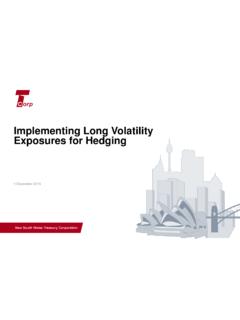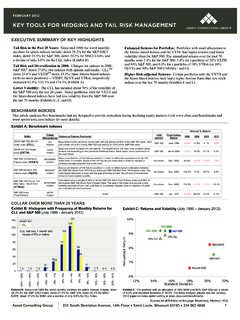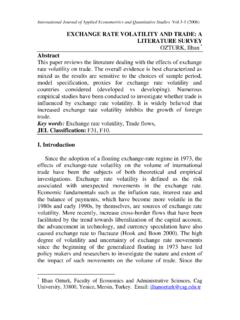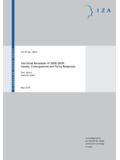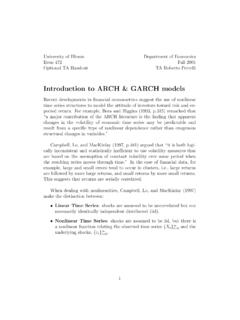Transcription of Cboe Volatility Index (VIX®)
1 Cboe Volatility Index (VIX ). Index Rules & Methodology April 2018. 400 S. LaSalle St.| Chicago, IL 60605. Cboe Global Markets 2008 - 2018 - All Rights Reserved Table of Contents Index Construction .. 3. Overview .. 3. The VIX Index Formula .. 3. Time to Expiration for Constituent Options .. 4. Risk-Free Interest Rates .. 4. Selecting the options to be used in the VIX Index 5. Determining prices for the selected options .. 6. Determining the contribution of both near-term and next-term options .. 7. VIX Index Filtering Algorithm .. 7. Calculation of VIX Special Opening Quotation.
2 8. Related VIX Values .. 9. Historical VIX Index Prices .. 9. Index Governance .. 10. Index Advisory Oversight Body .. 10. Index Policy .. 11. Conflicts of Interest Disclosure .. 11. Benchmark Complaint Investigation .. 11. Cessation and Change 11. VIX Index Methodology Maintenance Procedures .. 12. Delisting of SPX Options Contracts .. 12. Contact 12. Index 13. Disclaimer .. 14. 2. Index Construction Overview Cboe Exchange, Inc. (Cboe), in its capacity as a reporting authority, calculates and disseminates the Cboe Volatility Index commonly known as the "VIX Index " (ticker: VIX).
3 The VIX Index is a financial benchmark designed to be an up-to-the-minute market estimate of the expected Volatility of the S&P 500 Index , and is calculated by using the midpoint of real-time S&P 500 Index (SPX) option bid/ask quotes. More specifically, the VIX Index is intended to provide an instantaneous measure of how much the market expects the S&P 500 Index will fluctuate in the 30 days from the time of each tick of the VIX Index . Intraday VIX Index values are based on snapshots of SPX option bid/ask quotes every 15 seconds and are intended to provide an indication of the fair market price of expected Volatility at particular points in time.
4 As such, these VIX Index values are often referred to as indicative or spot values. Cboe currently calculates VIX Index spot values between 2:15 CT and 8:15 CT (Cboe GTH session), and between 8:30 CT and 3:15 CT. (Cboe RTH session). As described in greater detail below, Cboe applies a filtering algorithm to the calculation of spot VIX Index values in order to identify and suppress VIX Index values that, while reflecting SPX option quotes at a particular point in time, do not reflect the expected Volatility of the S&P 500 Index . Cboe, in its capacity as a reporting authority, also calculates and disseminates Special Opening Quotations.
5 ( SOQ ) of the VIX Index that are used as Final Settlement Values for VIX futures and VIX options. VIX SOQ values are calculated only once on the days that VIX futures and VIX options expire and are based on opening trade prices of SPX options with 30 days to expiration. The VIX Index Formula The generalized formula used in the VIX Index calculation 1 is: 2. 2 K i RT 1 F . 2 =. T. e Q( K i ) . T. 1 . i K i2 K0 . VIX VIX = 100. 100. T Time to expiration F Forward Index level derived from Index option prices K0 First strike below the forward Index level, F.
6 Ki Strike price of ith out-of-the-money option; a call if Ki>K0 and a put if Ki< K0; both put and call if Ki=K0. 1. See More Than You Ever Wanted to Know About Volatility Swaps, by Kresimir Demeterfi, Emanuel Derman, Michael Kamal and Joseph Zou, Goldman Sachs Quantitative Strategies Research Notes, March 1999, publicly available at: of-der. 3. Ki Interval between strike prices half the difference between the strike on either side of K i: K i +1 K i 1. Ki =. 2. (Note: K for the lowest strike is the difference between the lowest strike and the next higher strike.)
7 Likewise, K for the highest strike is the difference between the highest strike and the next lower strike.). R Risk-free interest rates to expiration Q(Ki) The average of the bid quote and ask quote for each option with strike Ki. Time to Expiration for Constituent Options The VIX Index measures the 30-day expected Volatility of the S&P 500 Index . The components of the VIX Index are at- and out-of-the-money put and call options with more than 23 days and less than 37 days to a Friday SPX. expiration date. These include AM-settled SPX options with standard 3rd Friday expiration dates and PM-settled weekly SPX options that expire every Friday, except the 3rd Friday of each month 2.
8 Once each week, the SPX. options used to calculate the VIX Index roll to new contract maturities. For example, on the day before VIX. futures and VIX options expiration, the VIX Index is generally calculated using two SPX option expirations: (1) one expiring 24 days later ( , near-term ) and, (2) one expiring 31 days later ( , next-term ). On the following day, the SPX options that expire in 30 calendar days become the near-term options and the SPX options that expire a week later are rolled in as the next-term options. The VIX Index calculation measures time-to-expiration in calendar days and divides each day into minutes in order to replicate the precision that is commonly used by professional option and Volatility traders.
9 N represents time- to-expiration in minutes and T represents time-to-expiration in years. The time-to-expiration is given by the following expressions: N = MCurrent day + MSettlement day + MOther days T = N / Minutes in a year MCurrent Day = minutes remaining until midnight of the current day MSettlement day = minutes from midnight until 8:30 for standard AM-settled SPX expirations;. or minutes from midnight until 3:00 for weekly PM-settled SPX expirations MOther days = total minutes in the days between current day and expiration day Risk-Free Interest Rates The risk-free interest rates, R1 and R2, are yields based on Treasury yield curve rates (commonly referred to as Constant Maturity Treasury rates), to which a cubic spline is applied to derive yields on the expiration dates 2.
10 If the expiration date for Friday-expiring S&P 500 Index options is moved due to an exchange holiday, the time to expiration for constituent options will be adjusted accordingly. 4. of relevant SPX options. As such, the VIX Index value calculation may use different risk-free interest rates for near- and next-term options. Selecting the options to be used in the VIX Index calculation The selected options are out-of-the-money SPX calls and out-of-the-money SPX puts centered around an at-the- money strike price, K0. K0 is defined as the strike price that equals or is immediately below the forward Index level, F, for the near- and next-term options: Fj = Strike Pricej + eRjTj x (Call Pricej - Put Pricej).
